Intention to Preach for Wildlife Protection in Sumatra Indonesia
DOI:
https://doi.org/10.29313/mimbar.v39i1.2043Keywords:
Clerics, Islamic Conservation Ethic, Rimbang BalingAbstract
This study analyzes the involvement of Clerics at the grassroots that help the implementation of the MUI Fatwa No 4/2014 regarding protected wildlife for the balance of the ecosystem. This study measures their knowledge-attitude-practice (KAP) and intentions to preserve nature and wildlife in conservation areas. The Clerics were invited from 11 villages surrounding Rimbang Baling Wildlife Sanctuary (RBWS), Riau. The clerics strengthened and trained to understand Islamic conservation ethics, accepting the fatwas and intensive guidance and information on da'wah, then tested using questionnaires before and after the training. The survey was conducted by providing 15 question indicators. ANOVA test results showed that the pre-test and post-test had significant F test results, with a sig value < 0.05. The relationship between attitudes, norms, behavior, and knowledge to conserve wildlife before training was R = 0.547 and after training was R = 0.662. The variables affect wildlife conservation actions by 37.4%.
References
Bhagwat, S.A, Ormsby, A.A, Rutte, C. (2011). The Role of Religion in Linking Conservation and Development: Challenges and Opportunities. Journal for the Study of Religion, Nature & Culture, 5(1). https://doi.org/10.1558/jsrnc.v5i1.39
Fishbein, M., & Ajzen, I. (2011). Predicting and changing behavior: The reasoned action approach. Psychology press. https://doi.org/10.4324/9780203838020
Hasan A*, Noordina T. A, & Sulaimana. (2010). The status on the level of environmental awareness in the concept of sustainable development amongst secondary school students. Procedia-Social and Behavioral Sciences, 2(2), 1276-1280. doi:10.1016/j.sbspro.2010.03.187
Khalid, F. (2010). Islam and the Environment – Ethics and Practice an Assessment. Religion Compass, 4: 707-716. doi:10.1111/j.1749-8171.2010.00249.x
Majelis Ulama Indonesia (MUI). (2014). Fatwa Tentang Pelestarian Satwa dilindungi untuk Keseimbangan Ekosistem. Komisi Fatwa MUI Pusat. Jakarta.
Mangunjaya, F. A. (2011). Developing Environmental and Conservation Awareness through Islamic Teaching. Oxford Journal of Islamic Studies, 22 (1): 36-49. https://doi.org/10.1093/jis/etq067
Mangunjaya, F. M. & McKay, J. (2012). Reviving an Islamic approach for environmental conservation in Indonesia. Worldviews: Global Religions, Culture, and Ecology. 16(3), 286-305. 10.1163/15685357-01603006.
Mangunjaya, F. M., & Praharawati, G. (2019). Fatwa on Boosting Environmental Conservation in Indonesia. Religions, 570; https://doi.org/10.3390/ rel10100570
Mangunjaya, F. M., Elkin, C., Praharawati, G., Tobing, I. S., & Tjamin, Y. R. (2018). Protecting of Tigers with a Fatwa: Lesson learns on faith base approach for conservation. Asian Journal of Conservation Biology, 7(1), 78-81. ISSN 2278-7666
McKay, J. E., Mangunjaya, F. M., Dinata, Y., Harrop, S. R., & Khalid, F. (2014). Practice what you preach: a faith-based approach to conservation in Indonesia. Oryx, 48(1), 23-29. DOI: https://doi.org/10.1017/S0030605313001087
McKay, J. E., St. John, F. A., Harihar, A., Martyr, D., Leader-Williams, N., Milliyanawati, B., ... & Linkie, M. (2018). Tolerating tigers: Gaining local and spiritual perspectives on human-tiger interactions in Sumatra through rural community interviews. PLOS ONE, 13(11), https://doi.org/10.1371/journal.pone.0201447.
Mcleod, E., & Palmer, M. (2015). Why conservation needs religion. Coastal Management, 43(3), 238-252. http://dx.doi.org/10.1080/08920753.2015.1030297
Nurdeng, D. (2009). Lawful and unlawful foods in Islamic law focus on Islamic medical and ethical aspects. International Food Research Journal, 16(4), 469-478.
Adeney-Risakotta, B.T. (2018). Living in a Sacred Cosmos: Indonesia and the Future of Islam (Southeast Asia Studies, 66; New Haven: Yale University Press.
Palmer, M. & Vinlay. (2003). Faith in conservation: new approaches to religions and the environment. Washington, DC: The World Bank.ISBN0821355597
Praharawati, G., Mangunjaya, F. M., Saragih, H. M., Firdaus, A. Y., Mulyana, T. M., Ilmi, F., ... & Sinaga, E. (2021). A Model of Religious Moral Approach for Peatland Ecosystem Restoration in Indonesia. Jurnal Manajemen Hutan Tropika, 27(2), 132-132. https://doi.org/10.7226/jtfm.27.2.132
Sodiq, M. (2014). Dualisme Hukum di Indonesia: Kajian Tentang Peraturan Pencatatan Nikah Dalam Perundang-Undangan. Al-Ahwal: Jurnal Hukum Keluarga Islam, 7(2), 109-120.
Sugiono. (2010). Metode Penelitian Bsnis. ALFABETA Bandung. (15). ISBN9789798433245.
Downloads
Published
Issue
Section
License
Copyright (c) 2023 MIMBAR : Jurnal Sosial dan Pembangunan

This work is licensed under a Creative Commons Attribution-NonCommercial-ShareAlike 4.0 International License.














